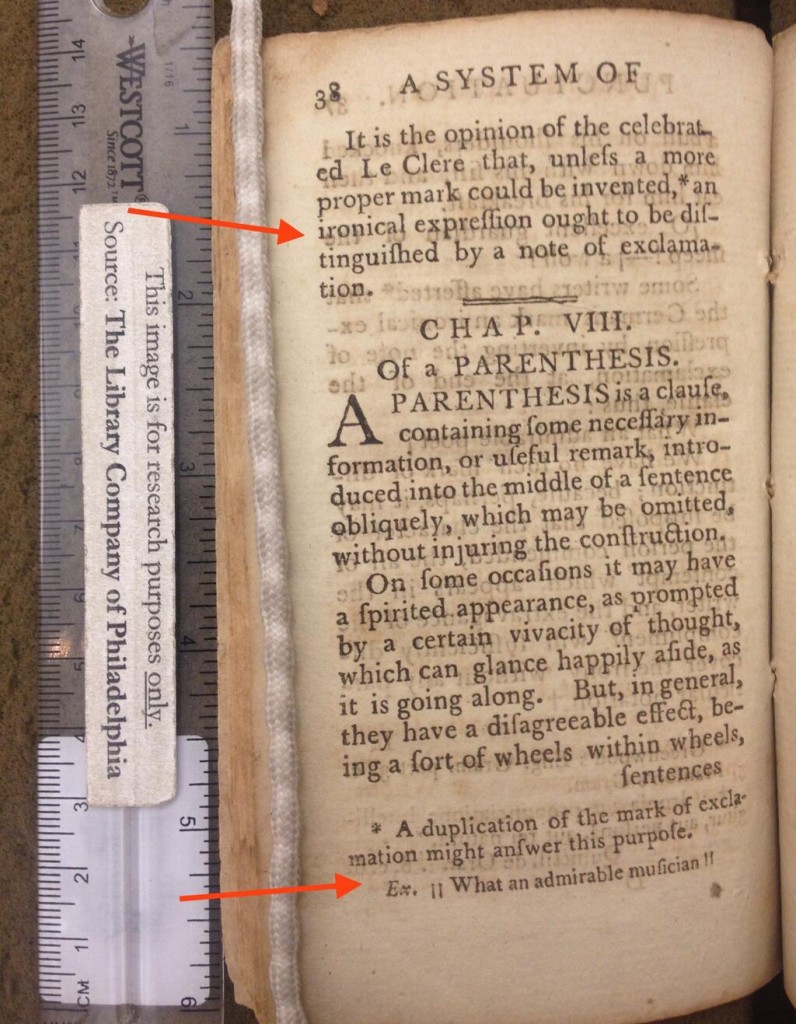A grab-bag of miscellaneous links for you this week; I am knee-deep in nineteenth-century printing history at the moment, courtesy of The Book. Enjoy!
After writing about irony marks again recently (specifically, Michele Buchanan’s project to introduce an irony mark along with two other marks of punctuation), I was simultaneously happy and dismayed to come across yet another irony mark on Twitter recently. This one, however, is something of a blast from the past.

Now this is interesting. Readers of the Shady Characters book will recall that a very similar proposal was made in 1668 when John Wilkins, one of the founding members of the Royal Society,1 published a book entitled An essay towards a real character, and a philosophical language.2 This “real character” and its associated “philosophical language” were a kind of ontological experiment designed to represent literally anything under the sun by means of a single, unified written and spoken language.
We all know how well that went.
Almost as an afterthought, Wilkins suggested that ironic statements might be punctuated by an inverted exclamation mark, or ‘¡’. This, too, was a flop, though the idea has had a bit of a resurgence in recent years, as we’ve seen here. What makes Joseph Robertson’s mark interesting, then, as mooted in his 1792 book A clear and practical system of punctuation,3 is not just that it represents another use of ‘¡’ for irony but that it comes just 124 years later. It closes the gap quite between the seventeenth and twentieth centuries quite considerably — is this part of a longer, unbroken chain, perhaps? Any evidence of this would be very much appreciated.
The editors of the OED recently announced that the word “hashtag” is to be added to their hallowed pages.4 This is, arguably, less interesting than recent French moves to re-brand the hashtag as the mot-dièse, and still less so than the vexed question of where the ‘#’ got the name “octothorpe”, but we can be happy at least that this venerable mark continues to enjoy a new lease on life.
And finally, via the BBC, an exercise for the reader: how does one write about a poem consisting only of punctuation?
Thanks for reading!
- 1.
-
Chambers, R., and R. Carruthers. “Dr John Wilkins”. In Cyclopædia of English Literature. Gould, Kendall and Lincoln, 1847.
- 2.
-
Wilkins, John. An Essay towards a Real Character, and a Philosophical Language. Printed for S. Gellibrand [etc.], 1668.
- 3.
-
Robertson, J. A Clear and Practical System of Punctuation : Abridged from Robertson’s Essay on Punctuation : For the Use of Schools. Boston: I. Thomas and E.T. Andrews, 1792.
- 4.
-
OED Online. “Hashtag”.
Comment posted by Athel Cornish-Bowden on
The inverted exclamation point ¡ is of course used in modern Spanish (but not, I think, in Catalan or Portuguese) to introduction an explanation (along with ¿ to introduce a question). I’ve always thought that these serve a useful purpose, and occasionally use them in English, but I’m not aware of any other languages that use them. Are there any?
Comment posted by Keith Houston on
As far as I know, ‘¡’ is used only in Spanish. We talked a little about ¡mixing? inverted exclamation marks and question marks a few months ago here on Shady Characters, but the discussion focused on their use in Spanish. Sorry I can’t be of more help!
Comment posted by Athel Cornish-Bowden on
After posting I did a search for “inverted exclamation mark” (a rather obvious search string, that I should have thought of at the outset), from which it appears that inverted marks have been used in Galician, Catalan and Waray-Waray. They seem to have largely disappeared from Galician and Catalan, and maybe Waray-Waray. That’s a language of whose existence I was previously unaware (it’s spoken in the Philippines): the Wikipedia article on it says nothing about punctuation, and the phrasebook at http://wikitravel.org/en/Waray_phrasebook doesn’t show any examples of ¡ or ¿ ( though it has plenty of questions where ¿ might be appropriate).
Comment posted by Keith Houston on
Hi Athel — I should have done that too! Thanks for reporting back. I would think that the ‘¡’ is probably safe for use as an irony mark in English-language texts at least.
Comment posted by Dave Mattingly on
My favorite punctuation poem is “Hatless Atlas,” which was posted to usenet in 1998.
http://www.netfunny.com/rhf/jokes/90q3/poem2.html
Comment posted by Keith Houston on
Dave — that is tremendous. To quote just two lines:
is read as “dash at cash and slash base rate / wow open tab at bar is great”. Fantastic stuff. Thanks for the comment!
Comment posted by Mike Headon on
How about Willard R Espy’s octothorpe poem, quoted at http://obsoleteword.blogspot.co.uk/2006/01/second-wedding-day.html.
Comment posted by Keith Houston on
Excellent stuff! Thank you for the link. (The poem can be found here: http://obsoleteword.blogspot.co.uk/2006/01/second-wedding-day.html#c116489209605569718.)